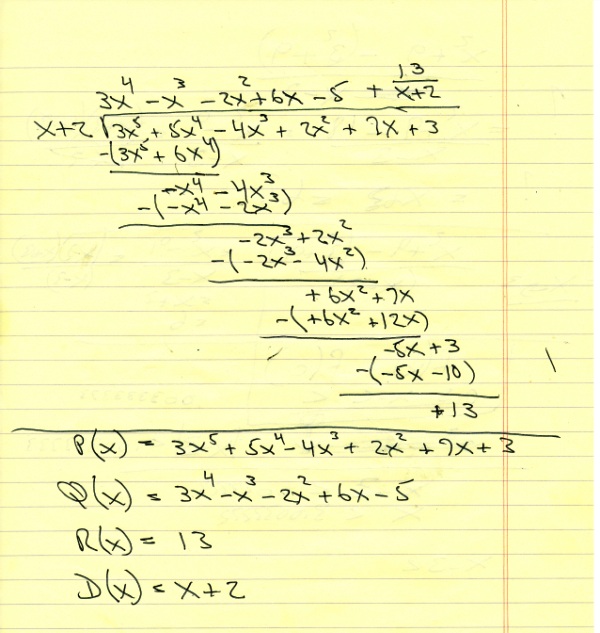
instruction on how to do long division can be found through the following link.
https://www.purplemath.com/modules/polydiv2.htm
to start, i divided 3x^5 by x to get 3x^4.
this was placed in the quotient area above the division line.
i then multiplied (x + 2) by 3x^4 to get 3x^5 + 6x^4
i then subtracted (3x^5 + 6x^4) from (3x^5 + 5x^4) to get -x^4
i then brought down -4x^3 to get (-x^4 - 4x^3)
i then divided -x^4 by x to get -x^3
this was placed in the quotient area above the division line.
i then multiplied (x + 2) by -x^3 to get (-x^4 - 2x^3)
i then subtracted (-x^4 - 2x^3) from (-x^4 - 4x^3) to get -2x^3
i then brought down 2x^2 to get (-2x^3 + 2x^2)
i then divided (-2x^3 by x to get -2x^2
this was placed in the quotient area above the division line.
i then multiplied (x + 2) by -2x^2 to get (-2x^3 -4x^2)
i then subtracted (-2x^3 - 4x^2) from (2x^3 + 2x^2) to get 6x^2
i then brought down 7x to get (6x^2 + 7x)
i then divided 6x^2 by x to get 6x
this was placed in the quotient area above the division line.
i then multiplied (x + 2 ) by 6x to get (6x^2 + 12x)
i then subtracted (6x^2 + 12x) from (6x^2 + 7x) to get -5x
i then broght down the 3 to get (-5x + 3)
i then divided -5x by x to get -5
this was placed in the quotient area above the division line.
i then multiplied (x + 2) by -5 to get (-5x - 10)
i then subtracted (-5x - 10) from (-5x + 3) to get 13.
that ended the division.
13 was my remainder.
13 can be shown as the reminder, or it can be shown as 13 / (x+2) in the quotient area.
if you read the instruction in the link provided, they will tell you pretty much the same thing.
the division is done by the first element in the divior to the first element in the dividend.
the dividend and divisor must be placed in descending order of degree if they are not already in that order.
there is an online polynomial division calculator that you can use to check your work.
that calculator can be found at https://www.symbolab.com/solver/polynomial-long-division-calculator/%5Cfrac%7B%5Cleft(3x%5E%7B5%7D%2B5x%5E%7B4%7D-4x%5E%7B3%7D%2B2x%5E%7B2%7D%2B7x%2B3%5Cright)%7D%7B%5Cleft(x%2B2%5Cright)%7D
my use of that calculator is shown below.


